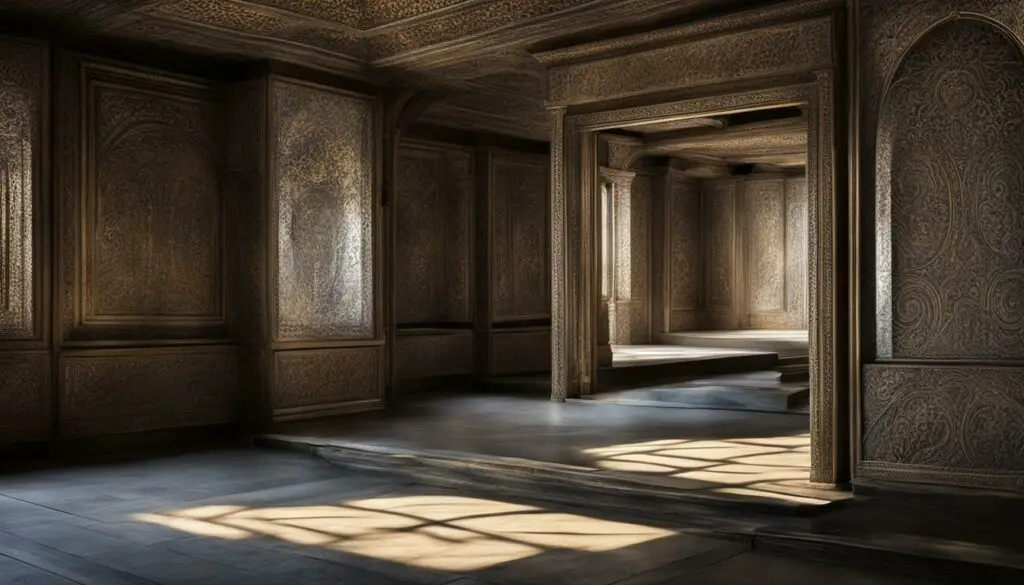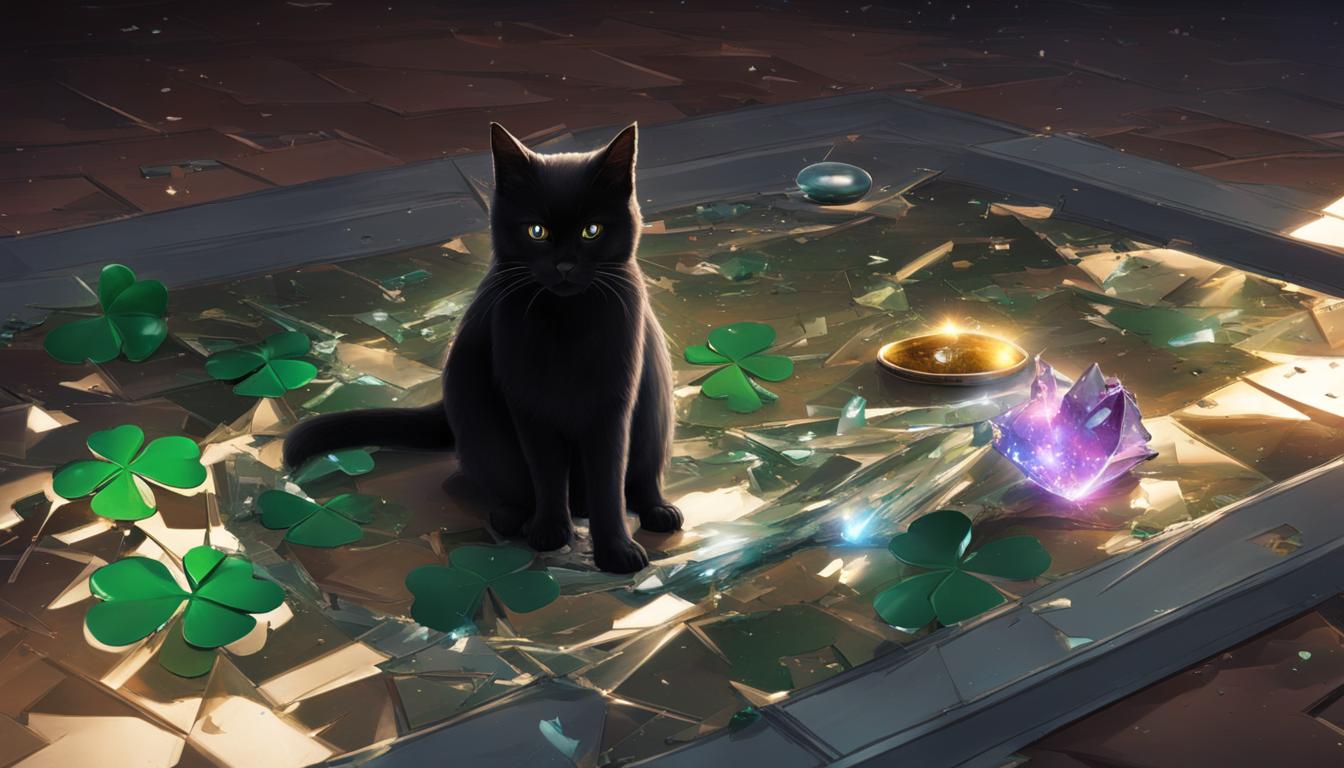Have you ever wondered if breaking a mirror brings bad luck? It’s a superstition that has been passed down through generations, but is there any truth to it? Let’s explore the fascinating world of mirror superstitions and uncover the facts behind this age-old belief.
Key Takeaways:
- Breaking a mirror and the associated bad luck belief originated in ancient Rome.
- Mirrors were believed to possess magical powers and were connected to one’s soul.
- Ancient Romans tied the duration of bad luck to their belief in the regeneration of the soul every seven years.
- Superstitions arise from humans’ instinctive thinking system and can provide a sense of control in uncertain situations.
- Scientifically, mirror superstitions have no basis in reality and should be viewed as cultural folklore.
The History of Mirror Superstitions
The belief that breaking a mirror brings bad luck is deeply rooted in ancient superstitions, particularly those of the Romans. They considered mirrors to possess magical powers and believed that they were portals to the soul. When a mirror was broken, it was believed that the soul would be disrupted and misfortunes would befall the person whose reflection it last held. This superstition is tied to the Roman belief in the renewal of life, which they believed took seven years. Hence, breaking a mirror was thought to bring seven years of bad luck.
The association between mirrors and the soul was prevalent in Roman culture. They believed that mirrors were divine instruments capable of revealing the future and that the reflection in the mirror was the actual soul of the person. Breaking a mirror was seen as a serious offense against the soul, as it signified the separation of the soul from the body.
To understand the consequences of breaking a mirror, it is essential to consider the Roman belief in the seven-year cycles of a person’s health. The Romans believed that a person’s well-being changed every seven years, hence the duration of the believed bad luck caused by a broken mirror. This notion of a seven-year cycle further reinforced the belief that breaking a mirror would bring prolonged misfortune.
Mirror Breaking Myths
Over time, various myths and superstitions surrounding mirror breaking have emerged in different cultures. Here are some common superstitions about mirrors:
- Breaking a mirror brings seven years of bad luck.
- If you stare into a broken mirror, you will have bad luck.
- Seeing your reflection in a mirror at night is an omen of death.
- Covering a mirror during a thunderstorm protects the household from lightning strikes.
- Hanging a mirror facing a bed invites unwanted spirits into your dreams.
| Superstition | Origin |
|---|---|
| Breaking a mirror brings seven years of bad luck | Ancient Roman belief in the soul and renewal of life |
| If you stare into a broken mirror, you will have bad luck | Unknown, likely a variation of the belief in the disruption of the soul |
| Seeing your reflection in a mirror at night is an omen of death | Folklore and cultural superstitions |
| Covering a mirror during a thunderstorm protects the household from lightning strikes | Folklore and cultural beliefs surrounding storms and mirrors |
| Hanging a mirror facing a bed invites unwanted spirits into your dreams | Folklore and cultural beliefs related to mirrors and spirits |
These superstitions vary across cultures and are often passed down through generations. While they may seem irrational, they continue to hold significance for many individuals.
The Psychological Reason Behind Superstitions

Superstitions and beliefs in luck have been part of human culture for centuries. But what drives us to hold on to these irrational beliefs, even in the face of logic and reason? Psychologists suggest that the psychological reasons behind superstitions lie in the way our minds think and the need for control.
According to psychologist Daniel Kahneman, humans have two systems of thinking. The first is a fast, instinctive system that quickly comes up with simple explanations for phenomena. This system often leads us to believe in superstitions, as it offers easy answers to events that may seem inexplicable. The second system is slower and more logical, countering superstitious thoughts with facts and evidence.
However, even when we recognize that superstitions are illogical, we may still engage in superstitious behaviors. This is because we view the potential cost of not completing the action as greater than the actual act itself. In uncertain situations, rituals and superstitious behaviors can help alleviate anxiety and restore a sense of control.
When it comes to mirror superstitions, such as the belief that breaking a mirror brings bad luck, the act of performing rituals or avoiding certain actions may provide individuals with a sense of control over their circumstances. Mirror-breaking rituals, for example, can serve as a way to cope with uncertainty and reduce anxiety. So while superstitions may not have any basis in reality, they offer psychological benefits to those who believe in them.
The Power of Rituals
Ritualistic behaviors, including those related to mirror superstitions, have been found to have a calming effect on individuals by providing a sense of structure and meaning. Whether it’s the act of breaking a mirror or avoiding certain actions, these rituals can help individuals regain a sense of control over their lives.
But it’s important to remember that superstitions are not based on scientific evidence. Mirrors themselves are not cursed objects, and the belief in their magical powers is rooted in ancient beliefs and cultural folklore. It’s up to individuals to decide whether they want to hold on to these age-old superstitions or embrace a more rational and evidence-based worldview.
In conclusion, superstitions about mirrors and bad luck are deeply ingrained in our culture and history. While they may not have any basis in reality, they continue to persist due to psychological reasons and the need for control in uncertain situations. Whether we choose to believe in superstitions or not, it’s important to approach them with a critical mind and view them as cultural traditions rather than factual truths.
Mirrors in Different Cultures

Throughout history, mirrors have held special significance in different cultures around the world, often associated with beliefs and superstitions. Let’s explore some of the fascinating mirror traditions and practices from various cultures:
Japanese Culture
In Japanese culture, mirrors have deep spiritual symbolism. The “Yata no Kagami,” a sacred mirror, is one of the three imperial regalia of Japan and is said to possess divine powers. Mirrors are also used in Shinto rituals and ceremonies to reflect and purify the soul.
Greek and Roman Mythology
In ancient Greek and Roman mythology, mirrors were associated with various deities. Mirror offerings were made to the goddess Venus, symbolizing beauty and self-reflection. Breaking a mirror was believed to harm one’s soul and bring bad luck, a superstition that has persisted to this day.
African and Native American Beliefs
Many indigenous cultures in Africa and Native American tribes have mirror-related beliefs and rituals. Mirrors are often used in divination practices, scrying, and communicating with spirits. They are seen as portals between the physical world and the spiritual realm.
| Culture | Mirror Beliefs and Practices |
|---|---|
| Japanese | Sacred mirrors, reflection of the soul |
| Greek and Roman | Association with deities, breaking brings bad luck |
| African and Native American | Divination, scrying, portals to the spiritual realm |
These are just a few examples of the rich and diverse beliefs surrounding mirrors in different cultures. While the specific superstitions and practices may vary, they all reflect the powerful symbolism and cultural significance of mirrors throughout human history.
Mirror Facts and Ancient Origins

Mirrors have a fascinating history that dates back to ancient civilizations. The earliest mirrors were made from dark substances, still water, or polished stones. In fact, polished obsidian mirrors have been discovered in various regions such as Turkey, Mesopotamia, Egypt, China, and Central and South America, dating back to 6000 BC. These ancient mirrors were used for practical purposes as well as for religious and ceremonial rituals.
However, it was in the 16th century that the modern mirror as we know it today was invented. Venetian glassmakers on the island of Murano developed the technique of applying a reflective coating to a glass plate, creating a clear and accurate reflection. This invention revolutionized the way mirrors were made and used, paving the way for the use of mirrors in art, fashion, and interior design.
Ancient mirrors not only served as tools for reflection but also held symbolic and spiritual significance in various cultures. They were believed to have the power to reflect the soul, and breaking a mirror was often associated with disrupting the soul and inviting misfortune. These beliefs and superstitions surrounding mirrors have persisted throughout history and continue to influence cultural beliefs and practices to this day.
Ancient Mirror Making Techniques
| Ancient Mirror Techniques | Description |
|---|---|
| Polished Stone Mirrors | Ancient civilizations used stones like obsidian, copper, and bronze that were polished to create reflective surfaces. |
| Metal-coated Mirrors | In the 16th century, the technique of coating glass with a reflective metal, such as silver or aluminum, was developed, resulting in clear and accurate reflections. |
| Water Mirrors | Still water was used as a reflective surface, creating a distorted but fascinating reflection. |
“Mirrors not only show us our reflection, but they also reflect the rich and diverse history of human civilization.”
The invention and evolution of mirrors have offered us a glimpse into the technological advancements and cultural significance of different eras. From the ancient polished stone mirrors to the modern glass mirrors, they have played a crucial role in shaping our understanding of ourselves and the world around us.
The ancient origins of mirrors continue to captivate our imagination and remind us of the timeless fascination with reflection and self-perception. While the superstitious beliefs surrounding mirror-breaking may persist, it is important to view mirrors as remarkable artifacts that have deep cultural and historical significance.
Breaking a Mirror and Soul Beliefs

The belief that breaking a mirror brings bad luck is often tied to the idea that a mirror reflects the soul. According to this superstition, breaking a mirror means breaking a part of the soul. Ancient Romans connected this belief to their belief in the regeneration of the soul every seven years. Hence, the seven years of bad luck associated with breaking a mirror represents the time it takes for the soul to renew and regenerate unbroken.
This notion of the mirror-soul connection is deeply rooted in ancient beliefs and cultural folklore. While a mirror is simply a physical object, it has been attributed with mystical powers and the ability to capture and reflect one’s essence. Breaking a mirror was seen as a disruption of this connection, causing the misfortune associated with the fractured soul.
Although modern understanding dismisses the idea of mirrors possessing magical qualities or reflecting the soul, the superstition of breaking a mirror and its subsequent bad luck continues to persist in various cultures. It serves as a reminder of the long-standing human fascination with mirrors and the symbolic meaning they hold in our lives.
In conclusion, the belief that breaking a mirror brings bad luck is steeped in ancient superstitions and the cultural significance attached to mirrors as reflections of the soul. While there may be no scientific basis for this belief, it remains a part of our shared human narrative, serving as a cautionary tale and a reminder of our complex relationship with the unknown.
Scientific Perspective on Superstitions

Superstitions have been a part of human culture for centuries, but from a scientific standpoint, they are viewed as irrational beliefs. Psychologists argue that superstitions arise from humans’ instinctive and fast thinking system, which seeks simple explanations for phenomena. The slower, logical thinking system counters superstitious beliefs with facts and evidence. However, despite this logical reasoning, people often continue to engage in superstitious behaviors due to the perceived cost of not completing the action outweighing the potential negative outcomes.
Scientifically, superstitions have no basis in reality and are considered to be products of human cognition. While they may provide individuals with a sense of control or comfort in uncertain situations, they are not grounded in any empirical evidence. Studies have shown that superstitions arise from a variety of psychological factors, such as a desire for control, pattern recognition, and our inherent cognitive biases.
“Superstition is the religion of feeble minds.” – Edmund Burke
Despite the lack of scientific evidence, superstitions continue to persist in various cultures and societies. They are often deeply rooted in tradition and folklore, passed down from generation to generation. However, it is important to approach superstitions with a critical mindset and recognize them for what they are – irrational beliefs that hold no factual basis.
Examples of Common Superstitions:
- Walking under a ladder is considered bad luck.
- Opening an umbrella indoors is believed to bring about misfortune.
- Breaking a mirror is associated with seven years of bad luck.
- Seeing a black cat crossing your path is often seen as a sign of bad luck.
- Avoiding cracks on the sidewalk is believed to prevent bad luck.
While these superstitions may be deeply ingrained in our cultural fabric, it is important to remember that they are not supported by scientific evidence. Superstitions should be seen as cultural traditions and folklore rather than objective truths.
| Superstition | Explanation |
|---|---|
| Walking under a ladder | Walking under a ladder is considered bad luck because it is associated with the symbol of a triangle, which is seen as a representation of the Holy Trinity. Breaking this sacred shape was believed to bring about misfortune. |
| Opening an umbrella indoors | This superstition can be traced back to ancient Egypt when umbrellas were used as protection from the sun god, Amun-Ra. Opening an umbrella indoors was seen as a sign of disrespect to the gods and was believed to anger them, thus resulting in bad luck. |
| Breaking a mirror | Breaking a mirror is associated with seven years of bad luck due to the ancient Roman belief that mirrors held magical powers and reflected one’s soul. Breaking a mirror was believed to bring about the separation of the soul from the body, leading to misfortune. |
| Seeing a black cat crossing your path | This superstition can be traced back to medieval times when black cats were associated with witchcraft and devilry. Crossing paths with a black cat was believed to bring about the influence of dark forces and bad luck. |
| Avoiding cracks on the sidewalk | This superstition is often associated with the belief that stepping on cracks would cause harm to one’s mother. It is rooted in the desire to protect and show respect for one’s family members. |
Debunking Mirror Superstitions
The belief that breaking a mirror brings bad luck is a superstition that has been passed down through generations. However, it is important to note that this belief has no scientific basis. Mirrors themselves are not cursed objects, and breaking one does not result in the manifestation of bad luck or misfortune. Instead, the concept of breaking a mirror and the associated bad luck is rooted in ancient Roman superstitions.
Ancient Romans believed that mirrors held magical powers and were a gateway to one’s soul. Breaking a mirror was seen as an act that severed the connection between the soul and the body, bringing about misfortunes and bad luck. The duration of this bad luck was tied to their belief that life renewed itself every seven years. Hence, the idea that breaking a mirror brings seven years of bad luck.
From a modern scientific perspective, superstitions like the belief in mirror-related bad luck can be attributed to the way human minds think. We have a fast, instinctive thinking system that seeks simple explanations for phenomena, often leading to the development of superstitious beliefs. However, our slower, logical thinking system counters these beliefs with facts. Despite this, people may still engage in superstitious behaviors due to the perceived cost of not completing the action outweighing the potential negative outcomes.
Superstitions are deeply ingrained in various cultures and should be approached as cultural folklore rather than objective truths. The belief that breaking a mirror brings bad luck is a reflection of ancient Roman superstitions and their beliefs in the power of reflection and the regeneration of the soul. It is important to view mirror-related superstitions through a lens of cultural understanding and recognize that there is no scientific evidence supporting the notion of mirrors being cursed objects.
Conclusion
In conclusion, mirror superstitions have deep roots in ancient Roman beliefs, where mirrors were seen as powerful objects with connections to the soul. The idea that breaking a mirror brings bad luck for seven years stems from these ancient superstitions. However, from a scientific perspective, superstitions are considered irrational beliefs without any factual basis.
Mirrors themselves are not cursed or magical, and breaking a mirror is simply a physical act that can result in potential harm. It is crucial to understand mirror superstitions as cultural folklore rather than objective truths.
While mirror superstitions continue to persist in various cultures, it is essential to approach them with a rational mindset. Breaking a mirror should be seen as a potential physical hazard rather than a gateway to bad luck or misfortune. By debunking mirror superstitions, we can embrace a more logical understanding of the world around us.
FAQ
Is breaking a mirror really bad luck?
No, breaking a mirror is not actually bad luck. The belief in bad luck associated with breaking a mirror is a superstition with no scientific basis.
Where did the belief in bad luck from breaking a mirror come from?
The belief dates back to ancient Rome, where mirrors were believed to have magical powers and breaking a mirror was thought to bring misfortune.
How long does the bad luck from breaking a mirror last?
According to the superstition, the bad luck is said to last for seven years, which is tied to the belief in the renewal of the soul every seven years.
Are there any cultural beliefs or superstitions about mirrors?
Yes, different cultures have various beliefs and superstitions about mirrors, including using mirrors for fortune-telling and cautioning newborn babies not to look at their reflection until their first birthday.
What is the history of mirrors?
Mirrors have a long history dating back to ancient civilizations, with the first mirrors made from dark substances, still water, or polished stones. The modern mirror with a reflective coating applied to a plate glass was invented in the 16th century.
Is there any scientific basis for superstitions?
Superstitions are considered irrational beliefs by scientists. They are believed to arise from humans’ instinctive and fast thinking system, while the slower, logical thinking system counters superstitions with facts.
Are mirrors really connected to the soul?
No, mirrors do not actually reflect the soul or have any magical powers. The belief in mirrors reflecting the soul is a superstition that originated in ancient Rome.
Can mirror superstitions be debunked?
Yes, mirror superstitions can be debunked as they have no scientific backing. Breaking a mirror is simply a physical act with potential consequences, not a gateway to bad luck or misfortune.

